Otto Ambros
| Otto Ambros | |
|---|---|
|
At the Nuremberg Trials, taken by the US Army | |
| Born |
19 May 1901 Weiden in der Oberpfalz |
| Died |
23 July 1990 (aged 89) Mannheim |
| Nationality | German |
| Fields | Organophosphate insecticides and nerve-agent chemicals |
| Institutions | IG Farben, BASF |
| Alma mater | University of Munich |
Otto Ambros (19 May 1901 – 23 July 1990) was a German chemist and Nazi war criminal, notably involved with the research of chemical nerve agents.
Early life
The son of a university professor, Ambros attended school and passed his Abitur exam in Munich. In 1920 he went to the University of Munich to study chemistry and agricultural science. In 1925 he gained a doctorate, studying under the 1915 Nobel Prize for Chemistry winner, Richard Willstätter.
Career
Beginning in 1926, Ambros worked at BASF in Ludwigshafen. In 1930 he spent a year studying in the Far East.
From 1934 he worked at IG Farben, becoming head of their Schkopau plant in 1935. His division of IG Farben developed chemical weapons, including the nerve agents sarin (in 1938) and soman (in 1944). In this capacity, he was an advisor to Carl Krauch, a company executive.
Ambros then managed the IG Farben factories at Dyhernfurth, which produced sarin and soman, and at Gendorf, which produced mustard gas, a skin irritant. In 1944 he was awarded the Knight's Cross of War Merit Cross. He was an expert on tabun, an extremely lethal chemical.
Arrest
Ambros was arrested by the US Army in 1946. He had tested poisons and chemicals on concentration camp inmates, and had overseen the IG Buna Werke rubber plant at Auschwitz. At Nuremberg in 1948 he was sentenced to eight years confinement, and was ultimately released from Landsberg Prison early in 1952.
Release from prison
After his release, he became an adviser to chemical companies such as W. R. Grace, Dow Chemical, as well as the U.S. Army Chemical Corps, and Konrad Adenauer.[1][2]
He was also advising Chemie Grunenthal now Grunenthal GmbH in the development of thalidomide.[3]
